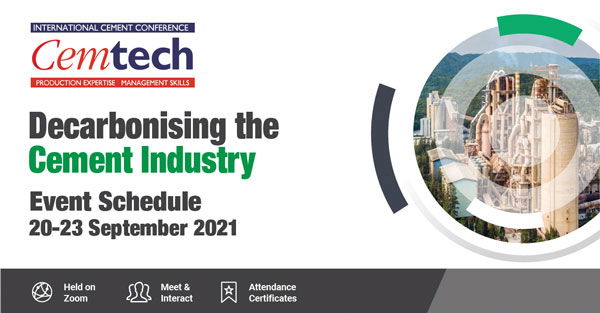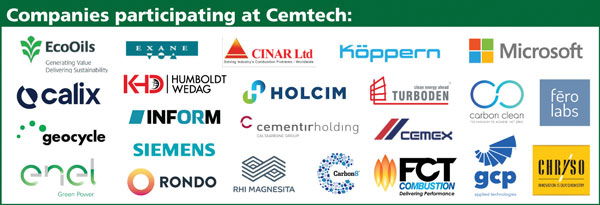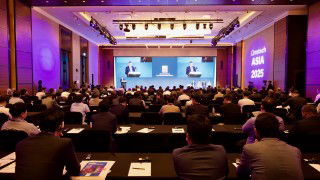Cemtech held its ‘Decarbonising the Cement Industry’ conference over Zoom on 20-23 September 2021, with attendees having the opportunity to hear from industry leading speakers spanning a range of fields linked to the sustainability of the cement sector. The challenge of moving to net zero remains a key consideration for the industry.

The Cemtech programme featured 25 presentations over eight sessions
Cemtech’s virtual conference, Decarbonising the Cement Industry, opened on Monday, 20 September 2021 with around 2000 attendees from over 120 countries – a clear indication of the challenges facing producers to respond to new rules and regulations regarding decarbonisation, whilst also meeting stakeholder expectations.
Magali Anderson, chief sustainability and innovation officer, Holcim Ltd (Switzerland), reiterated the net zero pledge made by the company one year ago, while highlighting its global challenges. The launch of the ECOPact and ECOPlanet green products forms part of the company’s pledge and already a clear appetite is being seen with ECOPact accounting for more than five per cent of concrete sales in India alone in the first six months. The group is also actively working on more than 30 carbon capture, utilisation and storage (CCUS) projects across 12 countries.
Davide Zampini, Cemex (Switzerland), also took a reflective look at the progress made by the industry so far. In addition, he explained the company’s slogan, Future In Action, with a new target of 475kg of CO2/t of cementitious material by 2030, the LEILAC project, solar-driven cement pyro-processing in collaboration with Synhelion, its gravity energy storage system, and the future role of recarbonisation.
“Recarbonisation is a process that has been overlooked for many, many years. It is one of the key characteristics of the material, so I think there is going to be a lot of work to better understand what it means when concrete recarbonates. Also, research into understanding how do we accelerate that process, improve that process and take advantage of that process,” said Mr Zampini.
In his analysis of the global cement sector and CO2 solutions, Paul Roger of Exane BNP Paribas (UK) considered CCUS schemes and the impact that these technologies will have on cement prices, with potential increases of 26-70 per cent, and the future role of novel and blended cements. Although he predicts six per cent like-for-like EBITDA growth in 2022 for the world (excluding China), cost inflation is spiking more than expected.
Pathways to net zero
The afternoon session began with Jim O’Brien of CSR Consulting (Ireland) looking closely at the industry’s 2030 sustainability ambitions. When analysing the sustainability performance of 25 cement companies, which account for 1.66bnt of cement production, around 40 per cent of global output, he looked at how trends are changing in terms of alternative fuel usage, alternative materials, clinker/cement ratios, kiln thermal efficiencies and net CO2 emissions, highlighting which companies are ahead of the game and those who have a long way to go to meet their peers.
Peter Hoddinott, independent consultant, gave a personal look into the future of the cement industry by 2050, examining what impact carbon taxation will have on costs and pricing, as well as analysing the global market in terms of demand, industrialisation and urbanisation. Predicting a huge reduction in clinker capacity by 2050, he also examined the future availability of slag, fly ash, pozzolan, limestone, etc.
Heinz Telser of RHI Magnesita rounded off the opening day with an explanation as to why the challenges facing the refractory sector are not unlike those facing the cement industry as a whole. Calcination/sintering accounts for around 85 per cent of CO2 emissions in the refractory industry and although there are many measures and technologies already in place to reduce this, there needs to be a greater focus on the circular economy. RHI Magnesita has collaborated with Holcim at its plants in Austria and Switzerland for the use of its ANKRAL Q2 LC bricks. Its new low-carbon (LC) range are old refractories recovered from kilns, which are reconditioned and then used as a raw material to make new high-quality refractory products with a lower CO2 footprint.
The digital cement plant
Robert Feldmann, Microsoft, delivered a presentation looking at the new wave of digital sustainability applications available and their adoption by the cement sector. “[I] am super convinced, particularly now with the sustainability pressures, that this adoption will accelerate tremendously, and also the technology is now available,” he said. Microsoft’s Hybrid Cloud technology allows for the management of thousands of edge devices.
Chandra Rangapura Shettappa of Siemens (Germany) outlined the company’s SiCement Operations kiln forecast and closed-loop solutions. The platform can predict key parameters of the kiln, such as sintering zone temperatures, 15-30min into the future and generate early warnings about trends in the process. This can lead to a reduction in energy consumption, emissions and opex.
Karsten Horn, Inform (Germany), considered the CO2 emissions that could be saved by optimising the logistics of cement producers, while Berk Birand of Fero Labs (USA) noted that the usage of machine learning by the industrial sector would increase if it moves away from black-box thinking and becomes an explainable solution.

Co-processing and AF advances
A further session began with Matthias Mersmann, KHD (Germany), looking at the importance of co-processing in decarbonising cement and the company’s solutions for optimum alternative fuel (AF) utilisation. Continuing this theme, Sharmistha Nandi and Steffen Blume, Geocycle/GIZ (Germany), explored how pre- and co-processing is a well-established part of the production process in developed countries, but uptake in developing/emerging economies is slow. Therefore, GIZ, FHNW, Holcim and Geocycle have updated global guidelines to support environmentally sound and safe waste co-processing in developing countries, which can be a part of a larger waste management plan in the country.
Finally, Michalis Akritopoulos, Cinar (UK), presented how ‘advance fuel switching’ may be considered an interim alternative to the more expensive CCUS technology in combating carbon emissions. Trials of hydrogen usage in the kiln, alongside biomass and plasma in the calciner, are underway.
Clinker substitution
Michele Di Marino and Stefano Zampaletta, Cementir (Italy), presented Cementir’s low-carbon cement portfolio. Its futurecemTM technology allows more than 35 per cent of clinker substitution with limestone and calcined clay. By 2030 futurecem sales are expected to reach around 51 per cent of all its sales volumes in Europe.
Kavidasan Kalibaskaran of EcoOils (Malaysia) followed this by showcasing its eco-processed pozzolan (EPP) product, a building material that is used to compliment cement in the construction industry. EPP is processed from the waste of palm oil refineries and prevents it going to landfill.
Elsewhere, Pedro Ladeira of FCT Combustion (USA) highlighted the company’s calciner technology which is used to produce green cement.
Renewable energy and WHR
John O’Donnell, Rondo Energy (USA), explained that renewable electricity is now lower cost than gas and is getting cheaper every year. Rondo’s Heat Battery technology has been designed to store low-cost intermittent energy, such as that delivered by solar or wind power plants, and deliver 24/7 high-temperature process heat. It is building its first 20MW installation in 2022 and is looking to supply internationally from 2023-24.
Anna Kowalczyk, Enel Green Power (Spain), continued by exploring the concept of power purchase agreements (PPAs), which are contracts between a company and renewable energy supplier to purchase power at an agreed price. A PPA can be customised according to the energy consumer’s consumption profile and sustainability targets, while also hedging the company against long-term price risk.
Sabrina Santarossa, Turboden (Italy), looked at waste heat recovery through organic Rankine cycle (ORC) systems. The company has many reference projects in the cement sector, where heat is recovered from a variety of process sources to produce electricity.
Energy efficiency and grinding
Kaushik Ghosh, Köppern (Germany), began the energy efficiency and grinding session by presenting the company’s upgrades to the wear protection, hydraulic and feeding systems at a cement plant.
Laurent Guillot, Chryso (France), looked at how cement additives can optimise clinker content in limestone-based cement and maximise SCM content in composite cements.
Jeffrey Thomas, GCP Applied Technologies (USA), highlighted how its CO2ST® Reducers technology is designed to reduce the CO2 clinker factor in cement by up to 10 per cent. An industrial case study shows that, as emissions were reduced by 60kg/t of cement, this could result in a €1.7m/year saving with the ETS carbon price set at €50/t.
CCUS technologies
Daniel Rennie of Calix (France) detailed the developments seen with the LEILAC projects, which captures process CO2 without adding chemicals or requiring significant changes to the production process. The LEILAC2 demonstration plant in Germany is set to capture around 20 per cent of emissions while proving the low-impact retrofit approach of the company.
Glen Bailey, Carbon Clean (USA), noted that current estimates put the CCUS market opportunity for carbon capture at more than US$1trn with the company itself having around 40 operational units capturing 800,000tpa of CO2. It is also on a pathway to reduce the size of the units by a factor of 10 while cutting the cost of capture to around US$30/t by 2023. Key references include Holcim, Cemex and Dalmia.
Elsewhere, James Evangelou of Carbon8 Systems (UK) delivered a presentation looking at the company’s Accelerated Carbonation Technology which treats industry waste, such as bypass dust, using captured CO2 to create a low-carbon product. This solution results in zero waste, thereby reducing costs for the producer, permanently captured CO2 and a carbon-negative aggregate as an end product.
This article was first published in International Cement Review in November 2021.
